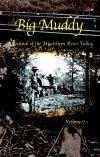
LSUP has also released its publication list for Spring 2007, which means that River of Dreams now has its own website here.
ISBN: 0-8071-3233-0 cloth
ISBN13: 978-0-8071-3233-3
272 pages, 26 Halftones, 1 Map, 6 x 9

 A first glimpse of the cover of River of Dreams: Imagining the Mississippi Before Mark Twain (Louisiana State University Press, Spring 2007). This is a first draft and subject to change before publication, but it gives a hint of what's to come. The background is a detail from Herzog Friedrich Paul Wilhelm von Württemberg's lithograph, Die Balize an der Mündung des Missisippi (1828-1835).
A first glimpse of the cover of River of Dreams: Imagining the Mississippi Before Mark Twain (Louisiana State University Press, Spring 2007). This is a first draft and subject to change before publication, but it gives a hint of what's to come. The background is a detail from Herzog Friedrich Paul Wilhelm von Württemberg's lithograph, Die Balize an der Mündung des Missisippi (1828-1835).
 'The Shanty-Boat' (from Willard Glazier's Down the Great River, 1887)
'The Shanty-Boat' (from Willard Glazier's Down the Great River, 1887) Admiral Porter's Fleet Running the Rebel Blockade of the Mississippi at Vicksburg, April 16th 1863 (Currier & Ives)
Admiral Porter's Fleet Running the Rebel Blockade of the Mississippi at Vicksburg, April 16th 1863 (Currier & Ives)Course outlines for two units that I will be convening at the University of East Anglia next year:
Nineteenth Century Representations of the Civil War:
The Civil War defined the American Nineteenth Century, and yet it has often been asserted that it was an 'unwritten war'. This unit will refute such claims, and examine the diverse ways that the conflict found expression throughout the nineteenth century, from Harriet Beecher's Stowe's Uncle Tom's Cabin (1851-2) – in Lincoln's words, 'the book that started this great war' – to the publication of Stephen Crane's Red Badge of Courage in 1895. We will encounter a rich variety of representations – documentary photography, journalism, letters and diaries, memoirs, poetry, song, popular fiction, children's literature, short stories and novels – and consider throughout what the changing nature of the imagined Civil War has to tell us about America.
(Update: full course outline available here.)
Nineteenth Century Literature of the American South:
This unit will explore the transformation of Southern literature in the nineteenth century and, in so doing, will examine the changing nature of the South itself. In the first half of the course, we will witness the emergence of a distinct Southern literary identity in the years before the Civil War, and particularly consider the effect of slavery on the development of Southern letters. In the latter half, we will encounter, through Reconstruction and beyond, the effects of defeat, liberation and memory, and their concomitant, contradictory expression in the diverse literary modes of poetry, plantation fiction, local colour and realism.
(Update: full course outline available here.)
My article on this year's Mardi Gras celebrations in New Orleans has been published in the New Statesman. Here's the first paragraph:
'Not for the first time in its history, New Orleans is being held together by glitter and glue. Much of the city is still in ruins, and rebuilding plans are being vehemently debated, but Mardi Gras festivities are proceeding as normally as they can - normally, that is, for New Orleans...'
